Do you know how you can use your TDEE for muscle gain? Building muscle is not just about lifting heavier or spending more time at the gym.
It’s also about fueling your body with the right amount of energy.
Your Total Daily Energy Expenditure (TDEE) tells you how many calories you burn in a day.
When you eat at that number, you maintain your current weight. But if your goal is to gain lean muscle, you’ll need to adjust your TDEE upward. Meaning you’ll eat a little more than your body burns.
The trick is doing it smartly. Because eating too much too fast leads to fat gain, not muscle gain.
In this article, you’ll learn exactly how to:
- Adjust your TDEE for a controlled calorie surplus
- Track your macros to make every calorie count
- And use your nutrition to build muscle efficiently, without unnecessary fat
Let’s start by breaking down what TDEE really means when your goal is muscle growth.

Table of Contents
Understanding Your TDEE for Muscle Gain
Your TDEE is the total amount of energy your body uses each day. It includes workouts, daily movement, and basic functions like breathing and digestion.
When you eat exactly your TDEE, your weight stays the same. But to build muscle, your body needs extra energy. The kind that fuels muscle repair and growth after your workouts.
Think of it like your TDEE is the “maintenance zone.” To gain muscle, you need to move into the “growth zone.” That means eating a calorie surplus, slightly more than what you burn daily.
But don’t go overboard. A small, steady surplus helps your body turn that extra energy into muscle, not fat.
How to Adjust Your TDEE for a Calorie Surplus (Without Gaining Fat)
Once you know your TDEE you will get the number of calories your body burns each day. The next step is to eat slightly more than that number. This gives your muscles the fuel they need to grow.
But how much is slightly more? That’s where most people go wrong, they eat too much, gain fat, and think “bulking” means unlimited calories.
Let’s break it down step-by-step to make it more clear for you:
1. Add 250-500 Calories to Your TDEE
According to different studies, a small calorie surplus of 10-15% above your TDEE is enough to promote lean muscle gain without significant fat gain.
For example:
| TDEE (Calories/day) | +10% Surplus | +15% Surplus | Recommended Intake |
| 2,000 | 2,200 | 2,300 | 2,250 |
| 2,500 | 2,750 | 2,875 | 2,800 |
| 3,000 | 3,300 | 3,450 | 3,400 |
A 250-500 calorie surplus per day typically supports a weight gain of 0.25-0.5 kg (0.5–1 lb) per week, which is considered optimal for lean muscle development.
2. Prioritize Protein
Calories alone don’t help with muscle gain. You need to add protein to your diet for that.
Aim for 1.6-2.2 grams of protein per kilogram of body weight per day, as supported by a 2018 meta-analysis in the British Journal of Sports Medicine.
| Body Weight | Protein Range |
| 60 kg (132 lbs) | 95–130 g/day |
| 75 kg (165 lbs) | 120–165 g/day |
| 90 kg (198 lbs) | 145–200 g/day |
Distribute your protein intake evenly across 3-5 meals to support muscle repair throughout the day.
3. Balance Carbs and Fats
Once protein is set, fill the rest of your calories with carbs and healthy fats:
- Carbs (45-55%) – your main energy source for workouts.
- Fats (25-30%) – support hormone balance and recovery.
Example for a 2,800-calorie surplus diet:
| Macronutrient | % of Calories | Grams per Day |
| Protein | 25% | ~175g |
| Carbohydrates | 50% | ~350g |
| Fats | 25% | ~78g |
4. Track Progress Every 2 Weeks
You’re aiming for slow, steady weight gain, mostly muscle.
If your weight isn’t increasing after 2-3 weeks, increase your intake by another 100-150 calories/day.
Use any reliable calorie tracker to log your meals and adjust as needed.
Avoid the Dirty Bulk Trap
Eating 1,000+ calories above your TDEE might seem like a fast way to grow, but it usually leads to fat gain.
Research found that larger surpluses increased body fat by 2–3x compared to smaller, controlled surpluses, with little extra muscle gain.
How to Track Your Macros for Maximum Muscle Gain
Once you know your calorie surplus, the next step is to make those calories work for you.
This is where macros, protein, carbs, and fats, come in. They decide whether your body builds muscle or stores fat.
1. Set your macro targets
Start with your total calories (your TDEE plus 250-500). About 25-30% of those calories should come from protein, 45-55% from carbs, and 20-25% from healthy fats.
Protein helps your body build and repair muscle. Carbs give you energy for workouts. And fats keep your hormones balanced.
2. Use a tracker app
You don’t have to guess or calculate by hand. There are many free online apps that can help you log your meals and see how close you are to your daily macro goals.
Use them for a few weeks. It gets easier once you learn what foods fit your plan.
3. Choose quality foods
Get your protein from foods like chicken, fish, eggs, or Greek yogurt. Get your carbs from rice, oats, potatoes, or fruits.
Add healthy fats from olive oil, nuts, or avocado. Whole foods give better results than processed snacks. They keep your energy steady and recovery faster.
4. Adjust as you go
Weigh yourself every two weeks. If you’re not gaining about half a kilo (1 lb) in that time, add 100-150 calories per day.
If you’re gaining too quickly or feeling bloated, reduce by the same amount. Small changes make progress steady and keep fat gain low.
5. Be consistent
You don’t need to be perfect, just stay consistent. If you stay close to your calorie and macro targets most days, you’ll build muscle and stay lean over time.
How to Combine Training and TDEE for Maximum Muscle Growth
Knowing your TDEE and eating in a calorie surplus gives your body the fuel to grow. But without the right kind of training, those extra calories won’t turn into muscle.
They will turn into fat. To build lean muscle, you need to combine smart nutrition with smart workouts.
1. Focus on Strength Training
Strength or resistance training is the main driver of muscle gain. It tells your body to use those extra calories for muscle repair and development.
Aim for 3-5 training sessions per week. Focus on targeting all major muscle groups, legs, chest, back, shoulders, and arms.
A simple structure:
- Day 1: Upper body (push movements like bench press, shoulder press, triceps dips)
- Day 2: Lower body (squats, lunges, deadlifts)
- Day 3: Rest or active recovery
- Day 4: Upper body (pull movements like pull-ups, rows, biceps curls)
- Day 5: Legs + core (leg press, calf raises, planks)
You don’t need fancy equipment. Even bodyweight exercises can work. What matters is progressive overload. Lift a bit heavier, do more reps, or improve your form over time.
2. Keep Cardio, But Don’t Overdo It
Cardio is good for your heart and recovery, but too much can eat into your calorie surplus. Stick to 2-3 light sessions per week.
Do it in a pattern of 20-30 minutes of walking, cycling, or light jogging. This keeps your endurance and metabolism healthy without slowing muscle growth.
3. Recover Like It’s Part of the Plan
Muscle gain happens outside the gym, not during workouts. Your training breaks down muscle fibers. Your nutrition and sleep help rebuild them stronger. To support recovery:
- Sleep at least 7-8 hours a night.
- Rest 1-2 days per week to avoid overtraining.
- Eat a protein-rich meal within 1-2 hours after your workout to jumpstart recovery.
4. Recalculate Your TDEE as You Grow
As you progress in your muscle gain journey, your TDEE increases. It is because muscle tissue burns more energy than fat.
Every 4-6 weeks, check your body weight and recalculate your TDEE using your new stats.
This ensures you’re still in a mild surplus, not under-eating or gaining unnecessary fat.
5. Track and Adjust Progress
A good pace for lean muscle gain is about 0.25-0.5 kg (0.5-1 lb) per week. If you’re not gaining, add 100-150 calories per day.
If you’re gaining too much too quickly, reduce slightly. Stay patient! Slow and steady muscle gain leads to better body composition and less fat gain.
Pro Tip:
Pair your training plan with a fitness tracker or workout log. It helps you connect your calorie intake (from your TDEE) with your workout output. It makes sure both work together toward muscle growth.

Common Mistakes When Using TDEE for Muscle Gain
Even with the right calories, small errors can slow your muscle gains or add fat. Below listed ones are the common mistakes people make when using TDEE for muscle gain:
1. Eating too large a surplus.
Many people eat too many extra calories thinking it will speed up muscle gain. But your body can only build so much muscle at a time.
Eating far above your TDEE mostly adds fat, not muscle. The smarter way is to stay in a small surplus, about 250 to 500 calories above your TDEE.
2. Not eating enough protein.
Protein is the main nutrient your body uses to repair and grow muscles after workouts.
Without enough of it, the extra calories you eat won’t be used efficiently. Aim for 1.6 to 2.2 grams of protein per kilogram of body weight daily.
3. Skipping progressive overload in training.
Some people also forget about progressive overload in training. Eating more calories helps only if your workouts challenge your muscles.
You need to gradually increase the weight, reps, or sets to keep making gains.
4. Overdoing cardio.
Too much cardio can also get in the way. While light cardio is good for health, doing it too often burns the calories your body needs for growth.
Keep cardio sessions short and limited to 2-3 times a week while focusing mainly on strength training.
5. Poor recovery and sleep.
Recovery is another key part of muscle growth that’s often ignored. Your muscles don’t grow during workouts. They grow while resting.
Poor sleep or lack of rest days can slow recovery and limit results. Try to get 7-8 hours of sleep each night and include rest days in your plan.
6. Inconsistent tracking.
Guessing portion sizes or skipping calorie tracking makes it hard to know if you’re in a surplus.
Track your meals and workouts regularly, and recalculate your TDEE every 4-6 weeks as you gain muscle, since your calorie needs will rise.
Avoiding these mistakes will help you gain lean muscle instead of unwanted fat, and make your TDEE strategy truly effective.
Frequently Asked Questions (FAQs)
1. How many calories over TDEE to gain muscle?
To build muscle, eat a little more than your body burns each day, about 250 to 500 extra calories.
Beginners can start with 100 to 300 extra calories to avoid gaining too much fat. Everyone’s body is different, so keep an eye on your progress and adjust as needed.
2. How to work out calorie surplus for muscle gain?
To figure out how many extra calories you need to build muscle, first find your TDEE using an online calculator.
Then add about 10–20% more, or around 300–500 extra calories. Check your weight every week, if you’re not gaining slowly, add a bit more food.
3. Will 3000 calories a day build muscle?
Yes, eating 3,000 calories a day can help build muscle if it is more than your body burns and you do strength training with enough protein. It only works if it keeps you in a calorie surplus above your maintenance level.
4. Does a calorie surplus increase muscle gain?
Eating about 2,500 extra calories per week can help you gain around one pound of muscle. This is an average estimate based on available research and may vary from person to person.
5. How to eat in a calorie surplus?
Eat more lean protein, healthy carbs, and good fats. Try to get extra calories from real, whole foods instead of junk food or sugary snacks. You can also add healthy snacks between meals to boost your intake.
Conclusion
Building muscle with your TDEE isn’t about eating as much as possible, it’s about eating smart. A small, consistent calorie surplus gives your body the fuel it needs to grow stronger without adding unwanted fat.
Remember, your TDEE is your guide. Adjust it slightly upward, hit your protein targets, train hard, and give your body enough rest. Track your progress every few weeks and make small changes instead of big jumps.
Over time, these steady habits build lasting results, more muscle, better strength, and a leaner body.

